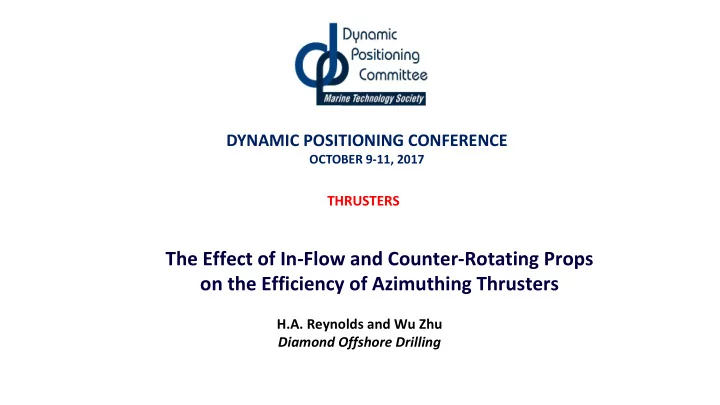

DYNAMIC POSITIONING CONFERENCE OCTOBER 9‐11, 2017 THRUSTERS The Effect of In-Flow and Counter-Rotating Props on the Efficiency of Azimuthing Thrusters H.A. Reynolds and Wu Zhu Diamond Offshore Drilling
The Effect of In-Flow and Counter-Rotating Props on the Efficiency of Azimuthing Thrusters H.A. Reynolds, Director R&D Wu Zhu, Structural Engineering Specialist Diamond Offshore Drilling, Inc.
Floating Factory Drillship Design LWL 222 Meters Beam 39 Meters Draft 11 Meters Displacement ~80,000 Metric Tons Thrusters (6) 5500 kW, 7-8 deg down-angle Props 4.3M φ , 4 knots in-rush
MARIN Tow Tank & Wave Basin Testing
Thruster Efficiency vs. Heading (DNV DP Analysis 4020.03 Rev. A) Thruster T1 T2 T3 T4 T5 T6 Heading 0 0.97 0.97 0.97 0.97 0.97 0.97 30 0.97 0.97 0.97 0.97 0.97 0.97 60 0.97 0.97 0.97 0.97 0.97 0.97 90 0.97 0.97 0.97 0.97 0.97 0.97 120 0.97 0.97 0.97 0.85 0.84 0.89 150 0.97 0.97 0.97 0.79 0.79 0.82 180 0.97 0.97 0.97 0.79 0.79 0.79 -150 0.97 0.97 0.97 0.79 0.79 0.82 -120 0.97 0.97 0.97 0.84 0.85 0.89 -90 0.97 0.97 0.97 0.97 0.97 0.97 -60 0.97 0.97 0.97 0.97 0.97 0.97 -30 0.97 0.97 0.97 0.97 0.97 0.97 Ref: Norbert Bulten & Petra Stoltenkamp. Improved DP Capability with Tilted Thruster Units and Smart Controls Algorithms . MTS-DP Conference Oct. 2016
Ocean Blackhawk Wake, Transiting Indian Ocean 7 deg down-angle thrusters, ~12 knots at 70% power, CW props
Ocean Blackhawk Wake, Transiting Indian Ocean 7 deg down-angle mechanical thrusters, ~12 knots at 70% power, CW props
Multi-Screw Propellers Rotation (from Astern) Conventional Twin Screw Conventional Thruster Counter-Rotation Rotation CFD Model Thruster Rotation (A) CFD Model Thruster Rotation (B)
Gear-Drive Thruster 7 Degree Down-Angle Spiral Bevel Gear Set Right-Hand Bull Gear Left-Hand Pinion Gear
Diamond Drillships Blackship (Gusto P-10000) Hull Floating Factory Hull
CFD Thruster Models 2 seats of CCM+ Software (cd-Adapco) • Diamond Cluster (200 cores) or TACC (1000-2000 cores) • K- Ω Solver • Sliding Contact at Propeller-Nozzle interface • Convergence Tests on Time-Step and Cell Size • Props monitored for cavitation •
Prop & Kort Nozzle “Trimmer” Mesh
Typical Prop-Tip Cavitation Floating Factory, Zero Degrees, 100% Power
CFD Correlation with Open-Water Thrust Thruster Force Percent Prop (Metric Tons) Input RPM Power Mfgr. CFD 100% 169 105 104.99 80% 157 90 90.01 60% 142 74 73.70 40% 124 57 56.88
Thruster Efficiency: DP Analysis vs. CFD Zero Degrees Azimuth, 80% Power Clock-Wise (CW) Props 105% T1 T2 T3 T4 T5 T6 100% 95% 90% “Wrong-Way” Props 85% DNV Efficiency 80% Floating Factory CFD 80% CW Props
Thruster Efficiency: Counter-Rotating Props Floating Factory, Zero Degrees Azimuth, 80% Power 105% T1 T2 T3 T4 T5 T6 100% 95% 90% 85% DNV Efficiency Floating Factory CFD 80% CW Props 80% Floating Factory CFD 80% Counter Rotation (A) Floating Factory 80% Counter-Rotation (B)
Thruster Efficiency: Hull Comparison Zero Degrees Azimuth, 80% Power 105% T1 T2 T3 T4 T5 T6 100% 95% 90% DNV Efficiency Floating Factory CFD 80% Counter Rotation (A) Blackships CFD 80% Counter-Rotaion (A) 85%
Thruster Efficiency: Various Headings Floating Factory, 80% Power, Counter-Rotation (A) 130% T1 T2 T3 T4 T5 T6 120% 110% 100% 90% DNV, 0-60 Degs 80% CFD 10 Degrees CFD 20 Degrees 70% CFD 30 Degrees CFD 60 Degrees
The Problem with Thruster T6: The Skeg
Velocity Plot, Cross-Section Through Thruster T2 Zero Degrees Heading, 100% Power, 99% efficiency
Velocity Plot, Cross-Section Through Thruster T2 30 Degrees Heading, 100% Power, 117% efficiency
Velocity Vectors, Cross-Section Through Thruster T2 Zero Degrees Heading , 100% Power, 99% efficiency
Velocity Vectors, Cross-Section Through Thruster T2 20 Degrees Heading , 100% Power, 117% efficiency
Velocity Vectors, Cross-Section Through Thruster T2 30 Degrees Heading , 100% Power, 117% efficiency
EfficiencyIncrease , TypicalBiasMode CFD Models vs. DP Analysis Floating Factory, 80% Power, Counter-Rotation (A) Thruster T1 T2 T3 T4 T5 T6 Heading 0 30 330 150 210 180 Efficiency Increase 0.8% 21.4% 21.4% 30.5% 30.5% 13.8%
Conclusions Down-angle thrusters virtually eliminate Coandă Effect, but make thruster efficiency highly dependent upon intake flows. Thruster efficiency varies significantly with: (a) Thruster Heading; generally highest normal to the turn of the bilge. (b) Prop Rotation; generally highest “ together at the top”. Thruster efficiency is similar between two hulls at Zero Degrees heading. Previous analytical methods don’t consider intake flows or prop rotation. Use CFD to optimize thruster efficiency on new-build DP vessels, including: • Varying thruster position • Optimizing hull shape (e.g. bilge radius, skeg design, etc.)
THE END
Recommend
More recommend